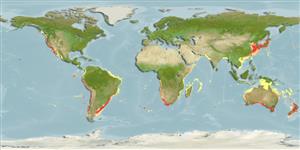Пластиножаберные (акулы и скаты) (sharks and rays) >
Hexanchiformes (Frill and cow sharks) >
Hexanchidae (Cow sharks)
Etymology: Notorynchus: Etymology not explained, presumably noto(s) (Gr.), back, possibly referring to posterior placement of single dorsal fin; rhynchus (L.), snout, possibly referring to broad, depressed snout. (See ETYFish); cepedianus: -anus, Latin adjectival suffix that means, when attached to a name, “belonging to”: Bernard Germain Étienne de La Ville-sur-Illon, comte de [count of] La Cepède (also spelled as La Cépède, Lacépède and Lacepède, 1756-1825), author of Histoire Naturelle des Poissons (1798-1803) and Péron’s “illustrious master” (translation) in ichthyology. (See ETYFish).
Environment: milieu / climate zone / depth range / distribution range
экология
морской; солоноватоводный демерсальный; пределы глубины 0 - 570 m (Ref. 26346), usually ? - 80 m (Ref. 5578). Subtropical; 56°N - 55°S, 131°W - 177°E (Ref. 54680)
Circumglobal: In tropical to temperate waters; except North Atlantic and Mediterranean Sea. Southwest Atlantic: southern Brazil to northern Argentina. Southeast Atlantic: Namibia to East London, South Africa (Ref. 5578). Western Pacific: southern Japan to New Zealand. Eastern Pacific: British Columbia, Canada to Chile. Record from India maybe erroneous.
Length at first maturity / Size / Вес / Возраст
Maturity: Lm 200.0, range 192 - 208 cm
Max length : 300 cm TL самец/пол неопределен; (Ref. 5578); common length : 150 cm TL самец/пол неопределен; (Ref. 6077); наибольший вес (опубликованные данные): 107.0 kg (Ref. 9987); наибольший возраст (опубликованны данные): 49 годы (Ref. 27952)
колючие лучи спинного плавника (общее число): 0; членистые (мягкие) лучи спинного плавника (общее число): 0; колючие лучи анального плавника 0; членистые (мягкие) лучи анального плавника: 0; позвонки: 123 - 157. A large seven-gilled cowshark (Ref. 5578) with a wide head, short and blunt snout, and fusiform body. Dorsal fin small, origin may vary from over insertion of pelvic fins to over free rear tips of pelvic fins. Anal fin smaller than dorsal fin. Tooth count 15-16/13. Reddish-brown to silvery-grey or olive-brown with numerous small black spots on body and fins; cream below (Ref. 5578).
Found on the continental shelf, often in shallow water (Ref. 247). Occurs close inshore, in bays and estuaries (Ref. 6871), with larger individuals ranging into deeper waters offshore and deep channels in bays (Ref. 247). Usually cruising steadily and slowly near the bottom (sometimes in water as shallow as a meter), but sometimes at the surface (Ref. 247). Can dash at speed when attacking prey (Ref. 247). Feeds on anything, including other sharks, rays, chimaeras, bony fish, hagfish, dolphin and porpoise meat, seals, shark egg cases, sea snails and mammalian carrion, including rats and humans (Ref. 5578). Ovoviviparous (Ref. 50449), with 82 to 95 young in a litter (Ref. 31395). Aggressive when provoked, and regarded as potentially dangerous to people in open waters (Ref. 247). It has attacked divers in captivity and may be involved in a few shark attacks off California and South Africa (Ref. 247). Often caught by anglers from the shore (Ref. 6574). Utilized for human consumption, its skin for leather, and its liver as a source of oil (Ref. 247).
Ovoviviparous, embryos feeding solely on yolk (Ref. 50449), with number of young reaching 82 in a litter. Gravid females apparently drop their young in shallow bays. Size at birth between 40 (Ref. 26346) and 53 (Ref. 247) cm. Distinct pairing with embrace (Ref. 205). Gestation period 12 months. The reproductive cycle appears to be biennial (Ref. 45445).
Compagno, L.J.V., 1984. FAO Species Catalogue. Vol. 4. Sharks of the world. An annotated and illustrated catalogue of shark species known to date. Part 1 - Hexanchiformes to Lamniformes. FAO Fish. Synop. 125(4/1):1-249. Rome, FAO. (Ref. 247)
Статус Красного Списка МСОП (Ref. 130435)
Использование человеком
рыболовство: коммерческий; объект спортивного рыболовства: да; аквариум: общественные аквариумы
дополнительная информация
ссылкиаквакультура (рыбоводство)особенности рыбоводствастепень растяжениягенетикаElectrophoresesнаследуемостьболезниобработкаNutrientsMass conversion
инструменты
Специальные отчеты
Скачать в формате XML
ресурсы в Интернет
Estimates based on models
Preferred temperature (Ref.
123201): 7.5 - 19.2, mean 14.2 °C (based on 122 cells).
Phylogenetic diversity index (Ref.
82804): PD
50 = 1.0781 [Uniqueness, from 0.5 = low to 2.0 = high].
Bayesian length-weight: a=0.00240 (0.00102 - 0.00563), b=3.14 (2.93 - 3.35), in cm total length, based on LWR estimates for this (Sub)family-body shape (Ref.
93245).
Trophic level (Ref.
69278): 4.7 ±0.2 se; based on diet studies.
устойчивость к внешним воздействиям (Ref.
120179): очень низкий, минимальное время удвоения популяции более 14 лет (rm=0.026; K=0.25; tm=16; tmax=32; Fec=82-95).
Fishing Vulnerability (Ref.
59153): High vulnerability (57 of 100).
Climate Vulnerability (Ref.
125649): High vulnerability (64 of 100).
Nutrients (Ref.
124155): Calcium = 13.3 [2.9, 63.2] mg/100g; Iron = 0.671 [0.165, 1.979] mg/100g; Protein = 20.1 [17.9, 22.2] %; Omega3 = 0.275 [0.123, 0.632] g/100g; Selenium = 43.1 [11.1, 117.0] μg/100g; VitaminA = 5.25 [1.65, 16.47] μg/100g; Zinc = 0.328 [0.161, 0.626] mg/100g (wet weight);
